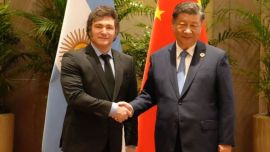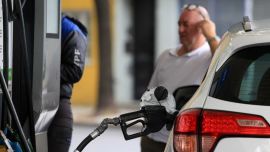It would be an absolute mistake, and a waste, to reduce Diego Armando Maradona to dichotomy, either a lost drug addict that wasn’t able to handle his fame or fortune, or a demi-god who emerged as the best footballer in the world and was therefore beyond good and evil. The complexities of understanding the multiple Maradonas are worthy of literary analysis more than psychology – Diego is a unique character that allowed the whole world to see the metamorphosis of a man and his circumstances for the past 60 years. And while it may be difficult to pull apart the different threads composing the complex narrative arc of his life, it goes beyond saying that the conditions that helped him become the most famous person in the world are long gone. Maradona was forged in the late 20th century, probably the last human era with some innocence left to it. A rebel to the bone, genuine, charismatic and 100 percent controversial, all of these and more constructed the myth of Diego.
Maradona’s life story responds to several of the archetypal characteristics of an epic poem of the ancient past, while his rise to fame accompanied the growth of modern communications technologies, particularly television. Born in 1960 in the Buenos Aires slum of Villa Fiorito, Pelusa’s initial journey embodied the “Argentine dream.” He was a poor boy with nothing more than a brilliant left foot whose family often didn’t have enough money to buy food for him and his brothers. He then used his magical talents to feed his siblings and buy momma Doña Tota a home. In that historic, famous first interview – when Diego was just a prodigal child who juggled the ball during half-time during Argentinos Juniors matches – he was asked what his dreams and ambitions were. “I want to play in the World Cup,” innocent Diego told the reporter, “and I want to win one.” Argentina was still a land of opportunity where it was possible to dream of breaking into the middle class, and Peronism’s flame was shining bright despite the death of Evita and General Juan Domingo Perón’s exile to Madrid, while the Cold War rivalry between Capitalism and Communism filled the soul with ideological yearning.
The 1960s gave way to the escalation of violence and death in the streets of Buenos Aires and the world during the 1970s, when the utopian dream was shattered with a baton, napalm and machine gun fire. Still known as ‘Peluza’ or hairball, Diego came of age as a teenager in the first division of Argentinos Juniors, humiliating his adult colleagues and filling a generation of Argentines with joy as the nation looked to football to escape the rising polarisation and militarisation of the streets, making his first division début the same year the Junta presided by Jorge Rafael Videla seized power from an embattled “Isabelita” Perón — the General’s widow. The political use of sports and superstars is older than the Roman Coliseum, and it took the military dictatorship little time to acknowledge the value of football. Videla and his cronies used the 1978 World Cup, hosted by Argentina, to try and project a global image of being “derechos y humanos” (a play on words on human rights), yet Maradona was forced to sit it out as Mario “El Matador” Kempes scored twice and, along with Daniel Bertoni’s final goal in the 115th minute in the final against the Netherlands, Argentina won football’s greatest prize. While this all played out at River Plate’s stadium. happened, the “disappeared” being tortured in the ESMA concentration camp just blocks away could hear the crowds. They were even taken out to witness the celebratory parade in the streets before being returned to their cells and eventually murdered or thrown out of a plane over the Río de la Plata. This Argentine reality clearly marked Diego, who would later have a close relationship with Estela de Carlotto, head of the Abuelas de Plaza de Mayo.
From slumdog to superstar, Diego completed his journey to Olympus during the 1986 World Cup in Mexico. It provided Maradona with a global stage, on which to play his role as epic hero, overcoming insurmountable adversity in the name of the disenfranchised. Everything about that quarter-final match against England held in the Azteca Stadium in Mexico City helped to cement the popular myth of Maradona. In an electric few minutes he demonstrated perfection by dribbling past the entire English team to score the ‘Goal of the Century’, and absolute cunning and deceit to punch the ball past goalkeeper Peter Shilton in the ‘Hand of God.’ He became the “cosmic kite,” flying higher than even Icarus could. As Maradona explained it, he felt as if he had picked the Queen’s pocket, humiliating the British and then cheating them out of the World Cup. It was the years after the Malvinas War and the final implosion of the military dictatorship leaving behind a fractured, torn, and absolutely demoralised Argentine society. To a greater or lesser extent, this was true of all of Latin America, and much of the “peripheral world,” as the Cold War came to an end.
The metaphor of Maradona as a crusader against the central powers is brilliantly explained by Serbian filmmaker Emir Kusturica in his documentary on ‘El Pibe de Oro.’ A big part of the world’s poor and forgotten belong to football-obsessed countries and for them, seeing Diego stick it to the Queen and win the World Cup felt like a Robin Hood moment, stealing from the wealthy to give to the poor. That same feeling was felt by the city of Naples, in southern Italy, where ‘El Diez’ is worshipped maybe even more than in Argentina. He arrived in 1984 to SSC Napoli, a weaker Italian side that was on constant risk of relegation, and he left in 1991 having won five titles, living proof to the wealthy clubs of the north like Juventus and Milan that if powered by Maradona nothing was impossible. To a certain extent, within popular culture, Maradona was becoming a sort of football version of Che Guevara or John Lennon figure.
The rebelliousness of Diego is one of his defining characteristics. On the pitch, it lifts him above the rest. Outside, in the realm of politics, it becomes controversial. After one of several rehabilitation trips to Cuba — we’ll touch on his drug addiction and eccentricity soon — he met Fidel Castro and quickly aligned himself with Venezuela’s Hugo Chávez, joining him in the infamous anti-George Bush march alongside Bolivia’s Evo Morales in Mar del Plata in 2005. As the ‘Pink Tide’ spread through South America, an empowered continent, fuelled by high commodity prices, said no to a wounded superpower. Diego had a profound hatred for the United States and what the hegemonic Western capitalist system represented, for all the contradictions. And he was absolutely aligned with the Kirchners, almost as much as he despised Mauricio Macri, whom he knew well from his second stint at Boca Juniors. This, of course, generated the rejection of a large portion of Argentine society.
Yet Maradona was a child of excess and exuberance. His drug addiction began in Barcelona and the party lifestyle thrived in Naples, where the Mafia also used him to its own benefit. He returned to Argentina in the 1990s, with Carlos Menem in charge, when a peso was worth a dollar. The world followed his repeated journey from relapse to recovery, driving Ferraris and dying his hair. Illegitimate children began appearing left and right. And then the winding down of a football career marked by his exit from the 1994 USA World Cup, escorted away by a nurse after a positive doping test. This wild and eccentric Maradona had massive popular appeal, exacerbated by the mass media which feasted on Diego and his hangers-on, but his rags-to-riches story and the later appearance of all sorts of unsavoury characters, along with infighting within the family, helped to erode part of the appeal. The longer he went on, the more the battle for Maradona’s riches became regular gossip show fare.
Maradona became the world’s most famous person in the world after the 1986 World Cup and retained that level of popularity until his death. One scene of Kusturica’s documentary shows what it felt like to be with him as the human hordes in Naples overcome safety barriers and lunge at his vehicle, throwing themselves onto it as an angered Maradona tries to get them to stand down, his fearful family sat quietly and uncomfortably. Similar images were seen in his public funeral this week at the Casa Rosada, Argentina’s presidential palace, where the government estimated one million people would come out. The popular folklore of football in its Argentine iteration was on full display, with hooligans inside Pink House and violent clashes with the police on the streets. President Alberto Fernández and VP Cristina Fernández de Kirchner were in the building at the time. Fortunately, things didn’t escalate beyond that.
The last Maradona was only a broken representation of what he came to signify, but he remained a living legend that was both worshiped and despised, as all superstars are. The stubbornness and rebelliousness that fuelled his feats on the pitch also prompted his consistent falls from grace. Yet, in his 20th-century innocence, Diego had a special type of intuition and a fiery tongue that has introduced countless phrases into Argentine popular parlance. And with that came an air of genuineness that no-one can deny.
He leaves us with a story that is impossible to replicate. A true character of our times, Diego Maradona.






















Comments